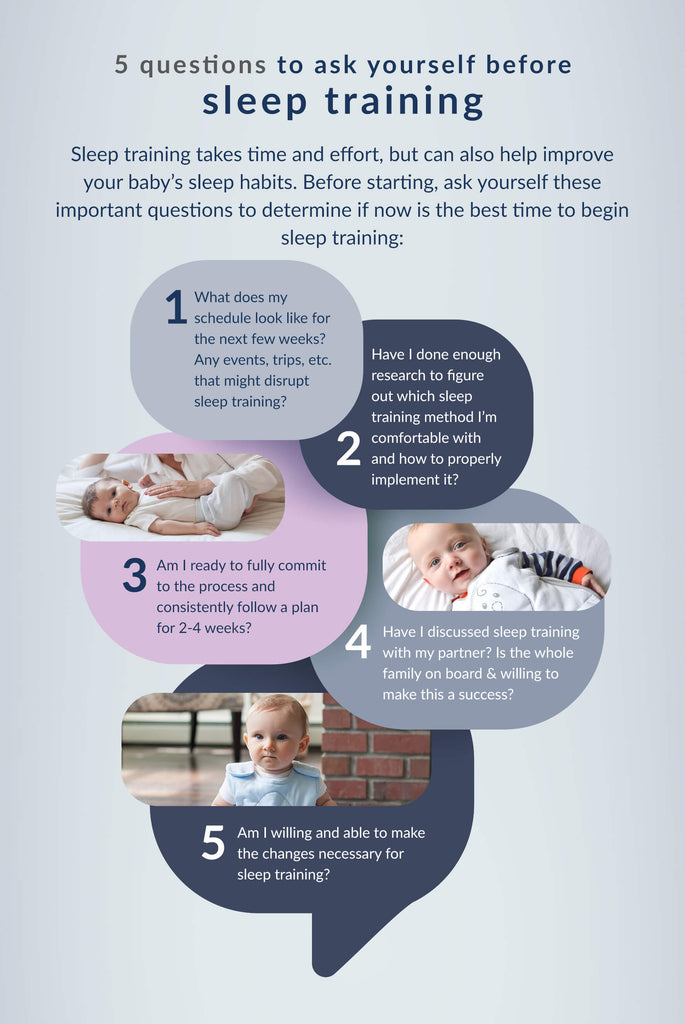Looking for the right baby sleep training method? It’s essential to find an approach that fits your family’s needs and philosophy while prioritizing your baby’s well-being.
There are various sleep training methods available, each with its unique strategies and techniques. As a parent, it’s important to understand the different approaches and consider factors such as your baby’s temperament, age, and your comfort level with the method.
By choosing a method that aligns with your family’s values and supports your baby’s healthy sleep habits, you can establish a sustainable and effective sleep routine that works for everyone. We’ll explore different baby sleep training methods and provide insights to help you find the right approach for your family.

Credit: www.nestedbean.com
Understanding Baby Sleep Training
When it comes to baby sleep training, every parent wants to find the right approach that suits their family’s needs. Understanding the various baby sleep training methods can be the first step in making informed decisions about your little one’s sleep routine.
Benefits Of Baby Sleep Training
- Establishing a predictable sleep pattern for your baby can promote healthy growth and development.
- It can improve the quality of sleep for both the baby and the parents, leading to better overall well-being.
- Implementing a sleep training method may help reduce night awakenings, resulting in more restful nights for the entire family.
Factors To Consider Before Starting
- Evaluate your baby’s age and readiness for sleep training, as some methods may be more suitable for older infants.
- Understand your parenting style and how it aligns with different sleep training approaches, such as cry-it-out or gentle methods.
- Consider any underlying medical conditions or developmental factors that may impact your baby’s ability to sleep train effectively.
:max_bytes(150000):strip_icc()/the-ferber-method-dr-ferbers-sleep-book-2634262-FINAL-784b0f3820c14a439e5458fe4de1af0f.png)
Credit: www.verywellfamily.com
Popular Baby Sleep Training Methods
Baby sleep training can be a daunting challenge, and with various methods available, navigating the options can be overwhelming. It’s important to find a sleep training method that aligns with your parenting style and your baby’s unique needs. Here is an overview of some popular baby sleep training methods:
Cry It Out Method
The Cry It Out method, also known as extinction, involves letting your baby cry in their crib until they fall asleep. This approach advocates for minimal parental intervention, allowing the baby to learn to self-soothe.
Ferber Method
The Ferber Method, developed by Dr. Richard Ferber, entails gradually increasing the amount of time before responding to a baby’s cries. This method aims to teach the baby to fall asleep independently while providing intermittent comfort.
Pick Up Put Down Method
The Pick Up Put Down Method involves promptly picking up a fussy baby when they start crying, then soothing them until they relax, and finally placing them back in the crib. This process is repeated until the baby falls asleep.
No Tears Method
The No Tears Method, also referred to as the gentle approach, emphasizes minimizing distress for both the baby and the parent. This method involves nurturing the baby to sleep through gradual and gentle techniques.
Choosing The Right Method For Your Family
Find the perfect baby sleep training method that suits your family’s needs. Discover effective approaches to help your little one sleep soundly through the night.
When it comes to baby sleep training, finding the right approach for your family is crucial. With the wealth of information and various methods available, it can feel overwhelming to decide which one to follow. However, by assessing your family’s needs, considering your parenting style, and seeking professional advice, you can narrow down the options and choose a method that suits you and your little one perfectly.
Assessing Your Family’s Needs
Assessing your family’s needs is the first step towards finding the most effective sleep training method. Every family is unique, and what works for one may not work for another. Take into consideration factors such as your baby’s age, temperament, and any special circumstances like breastfeeding or medical conditions. Some methods may be more suitable for newborns, while others are better for older infants. By understanding your specific situation, you can ensure that the chosen approach aligns with your family’s needs perfectly.
Considering Your Parenting Style
When it comes to sleep training, it’s essential to consider your parenting style. Each family has their own approach to raising their children, and it’s important to find a method that aligns with your values and beliefs. If you prefer a gentle and gradual approach, methods like the Ferber method may suit you. On the other hand, if you lean towards a more hands-on and responsive approach, methods like the No-Cry Sleep Solution might be a better fit. By choosing a method that resonates with your parenting style, you can feel confident and comfortable throughout the sleep training journey.
Seeking Professional Advice
Seeking professional advice can provide invaluable guidance when it comes to choosing the right sleep training method for your family. Consulting with a pediatrician or a sleep consultant can help you understand the pros and cons of different methods, as well as gain insights into how they may align with your unique circumstances. These professionals have extensive experience and knowledge in baby sleep, and their expertise can offer you personalized recommendations based on your baby’s specific needs. By seeking professional advice, you can make an informed decision that supports your baby’s sleep development in the best way possible.
Preparing For Baby Sleep Training
Creating A Sleep Routine
Establishing a consistent sleep routine is crucial for ensuring a smooth baby sleep training process. Babies thrive on predictability, and a well-structured sleep routine can help signal to your little one that it’s time to rest. Consistency is key here, so try to create a routine that you can maintain over the long term. A sample sleep routine might include:
- Set a regular bedtime:
- Bathtime:
- Wind down:
- Bedtime stories or lullabies:
- Create a calming environment:
By following a consistent sleep routine, your baby will soon learn to associate these activities with bedtime and will be more likely to fall asleep easily and stay asleep throughout the night.
Setting Up A Sleep-friendly Environment
Creating a sleep-friendly environment is another vital aspect of preparing for baby sleep training. Consider implementing the following tips to optimize your little one’s sleep space:
- Adequate darkness:
- Noise control:
- Comfortable temperature:
- Safe sleeping space:
Providing a peaceful and comfortable sleep environment will help your baby feel secure and promote better sleep quality. Remember, a calm sleeping space is conducive to a calm and restful sleep.
Tips For A Successful Baby Sleep Training
Looking for effective baby sleep training methods? Finding the right approach is key for success. Establishing a consistent bedtime routine and using gentle methods like gradual soothing and responsive settling can help your baby learn healthy sleep habits.
Being Consistent
Consistency is key when it comes to successful baby sleep training. Babies thrive on routine, so establishing a consistent sleep schedule can greatly improve their sleep patterns. Stick to a regular sleep and wake time each day, even on weekends, to help your baby’s internal clock become regulated. Being consistent with where your baby sleeps, whether it’s a crib or a bassinet, also helps create a predictable sleeping environment. Remember, consistency in implementing and following through with your chosen sleep training method is crucial for success.
Establishing A Bedtime Ritual
Creating a bedtime ritual is an effective way to signal to your baby that it’s time to wind down and prepare for sleep. This routine should be designed to be calming and soothing, helping your baby relax before bedtime. Consider incorporating activities such as a warm bath, gentle massage, or a lullaby into your routine. By consistently following the same sequence of events each night, you’re providing your baby with cues that sleep is approaching. This helps them transition from being awake to ready for sleep, making bedtime less of a struggle and more of a peaceful process.
Troubleshooting Common Challenges
While every baby is unique, there are a few common challenges that parents may encounter during the sleep training process. One of these challenges is separation anxiety, which can make it difficult for babies to fall asleep or stay asleep on their own. To address this, gradually increase the distance between you and your baby during sleep, starting with small steps such as moving from co-sleeping to a separate crib. Another common challenge is sleep regression, where a baby who previously slept well suddenly has trouble sleeping. Be patient and consistent in your approach during these times, and remember that regressions are usually temporary. Finally, teething can often disrupt a baby’s sleep. Offer comfort through gentle massages or teething rings, and if needed, consult with your pediatrician about appropriate pain relief options. By being consistent, establishing a bedtime ritual, and knowing how to tackle common challenges, you can set yourself up for success in your baby sleep training journey. Remember, every baby is different, so it may take time to find the right approach that works best for your family. Stay patient, be persistent, and trust your instincts as you navigate this important milestone in your baby’s development.
Frequently Asked Questions Of Baby Sleep Training Methods: Finding The Right Approach For Your Family
What Is The 5 3 3 Rule For Sleep Training?
The 5-3-3 rule for sleep training involves a consistent bedtime routine, setting a specific bedtime, and applying a gentle approach to soothe your baby to sleep. Establishing a calm environment, being responsive to your baby’s needs, and gradually increasing periods of crying are key components.
What Is The 3 5 10 Rule For Babies?
The 3 5 10 rule for babies refers to the recommended time intervals for feeding. It suggests that newborns should be fed every 3 hours, infants aged 1-6 months every 4-5 hours, and babies aged 6 months and older every 6-10 hours.
Adhering to this rule helps ensure the baby receives proper nourishment throughout the day.
What Is The 5 10 15 Rule For Sleep Training?
The 5 10 15 rule for sleep training is a method where you gradually increase the time between nighttime check-ins for a child. Initially, check on them every 5 minutes, then 10 minutes, and later 15 minutes. This helps them learn to self-soothe and fall asleep independently.
What Is The Lady Shuffle Method?
The lady shuffle method is a technique used in fitness to improve cardiovascular health. It involves alternating side steps and touches with your feet, mimicking a shuffle. By incorporating this exercise into your routine, you can boost endurance and burn calories effectively.
Conclusion
Ultimately, finding the right baby sleep training method for your family can be a process of trial and error. Remember, every baby is different, and what works for one may not work for another. Whether you choose the cry-it-out method, the fading method, or a combination of techniques, staying consistent and patient is key.
Trust your instincts as a parent and don’t be afraid to seek professional advice if needed. With time and perseverance, you will find a sleep training approach that works best for your little one and brings peace to your household.











